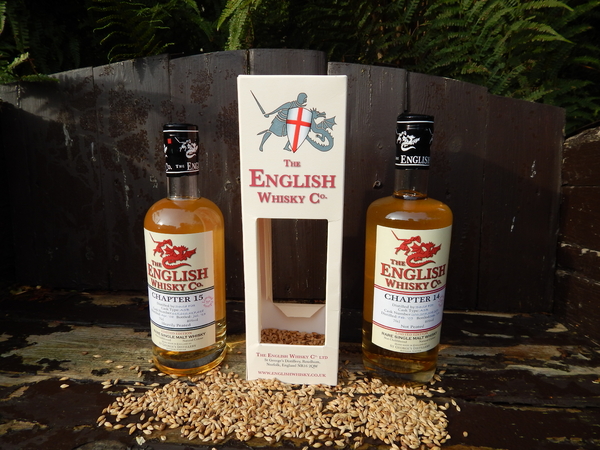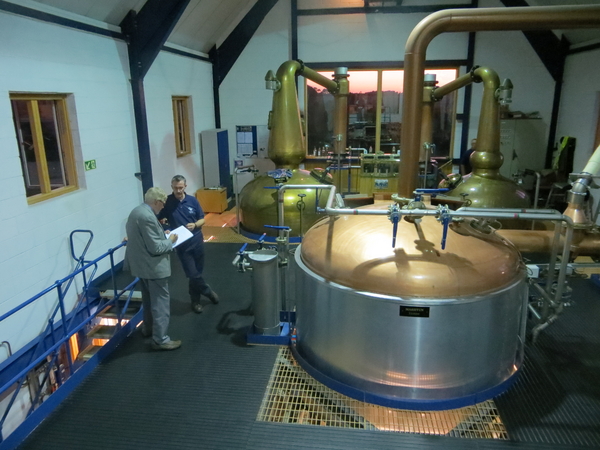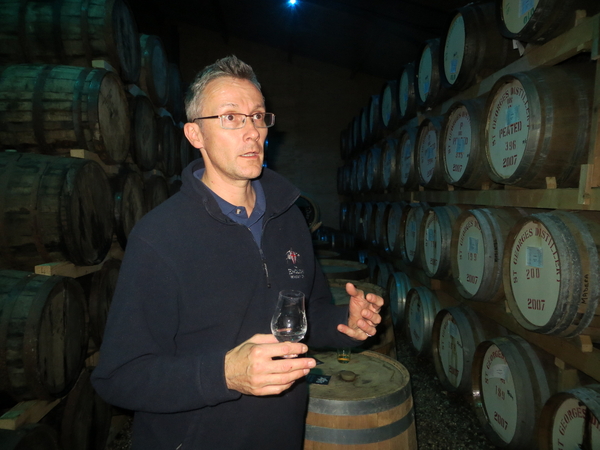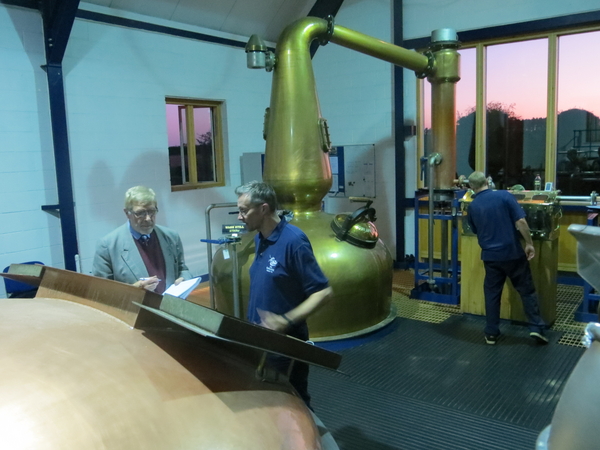English whisky wins top award
Added: Tuesday, November 4th 2014

The first English whisky distillery for more than a century has won a prestigious award from world-renowned writer Jim Murray. The 2015 edition of his Whisky Bible has named a single malt whisky produced by the St George’s Distillery in Norfolk the European Whisky of the Year.
In the unlikely setting of flat, bleak countryside between Norwich and Thetford, the English Whisky Company’s St George’s Distillery is producing single malt whisky of the highest calibre. It’s proved to be the catalyst that has brought distilling back to the life in England and encouraged several brewers – including Adnams in neighbouring Suffolk – to add gin, whisky and vodka to their portfolios.
There’s a powerful bond between beer and spirits. Both are made from grain – predominantly malted barley – and, in the world of whisky, distillers use a similar language. They speak of “the mash”, the mix of grain and hot water that produces a sweet extract called wort, which is fermented to make what they call the wash or beer. The only ingredient missing is hops, which are not used in whisky-making.
This is familiar territory for a brewer and at St George’s the head distiller is David Fitt who learned the brewing skills with Greene King in Bury St Edmunds before taking on the challenge of running the distillery (below David Fitt seen talking to Roger Protz by his mash tun).
St George’s was founded by the Nelstrop family who have grown and milled grain in the area for 500 years and thought it would make sense to move into whisky making. They knew there would be no quick profits: as well as such beer-making vessels as mash tuns and fermenters you have to add the giant pot stills, the essential pieces of equipment where the beer is twice distilled. Finally, you need oak casks – lots of them -- to age and store the spirit.

Then you sit back and wait three years, as legally you can’t sell a beverage called whisky until it has matured for that minimum amount of time. And if it’s made in England, you certainly can’t call it Scotch.
St George’s was built on farm land in 2006 with kit installed by the specialist Scottish distillery equipment company, Forysth. The renowned whisky distiller Iain Henderson, who had worked at Glenlivet and Laphroaig, was coaxed out of retirement to create the first batch of spirit that was run into oak casks bought from Bourbon makers in the United States. Job done, Henderson hung up his mashing fork for good and the Nelstrops head-hunted David Fitt.
When that first batch of St George’s single malt whisky was released in 2009 the world went crazy, according to David. “We sold the entire batch in three days. People were queuing from five in the morning and the police had to direct traffic from the main road.”
He lives on the premises with his family and as well as making whisky he helps run the spacious visitor centre and shop, and he conducts regular tours and tastings.
He says a lot of younger people, women included, are drinking whisky and he has no doubt the interest has been sparked by the craft beer movement and the close association between beer and whisky.
St George’s sold 150,000 bottles last year and is exporting to Canada, France, Germany, Hong Kong, Japan, the Netherlands and Sweden, with Russia showing an interest.

At home, the whisky is snapped up by specialist bars and even exclusive clubs in London and the distillery also produces a bespoke version for Marks & Spencer. At around £30-£40 a bottle, St George’s single malts are not cheap, but David Fitt believes that, in these straitened times, people occasionally want a special treat.
He has 2,500 casks in store (above). Most come from the American Bourbon industry including Jim Beam but he has some sherry casks as well. He blends spirit from several Bourbon casks or from both Bourbon and sherry containers. It’s the oak and its tannins that give whisky its tempting colour: the raw spirit that goes into the casks looks identical to gin and vodka.
David gets his bulk grain from Crisps of Great Ryburgh, a major Norfolk malting company that supplies breweries throughout the UK as well as Scottish distilleries. Specialist peated malt comes from Scotland.
He says whisky “is all about flavour. The industry is in growth worldwide and distilleries have to sell it younger. Lots of brands don’t have the age on them, which means they’re younger than malts used to be.
“I’m breaking the taboos. Using my brewing background, I’ve used chocolate and crystal malts, which don’t add colour but do add flavour. I’ve also used rye and oats.”
In the large brewhouse and distilling room, the fermented beer enjoys a slow and exhaustive double distillation in two large pot stills. After 12 hours, only one section of the spirit – the middle cut – is deemed suitable for ageing. The first and final sections, the foreshots and the feints, are returned to the stills to be blended with the next batch.
I tasted an unpeated five year-old Chapter 14 with honey, vanilla, lime and smoke on the nose and palate followed by a long finish with honey and vanilla to the fore and a hint of mint. Chapter 15 is a peated version with a minty, herbal, oak and vanilla nose, sweet fruit in the mouth balanced by mint, oak and spices, followed by herbs, cardamom, vanilla, smoke and oak in the finish.
I suspect demand will go through the roof when the news gets out that the company has won the Beer Bible’s top European award for the unpeated Chapter 14. The police should get ready to control the traffic again on the A11.
*St George’s Distillery, English Whisky Company, Harling Road, Roudham, Norfolk NR16 2QW. Signposted from A11 between Norwich and Thetford. www.englishwhisky.co.uk; [email protected]; 01953 717939.
Below: one of the giant pot stills at St George's.
*The Whisky Bible gives separate awards to Scottish distillers.







